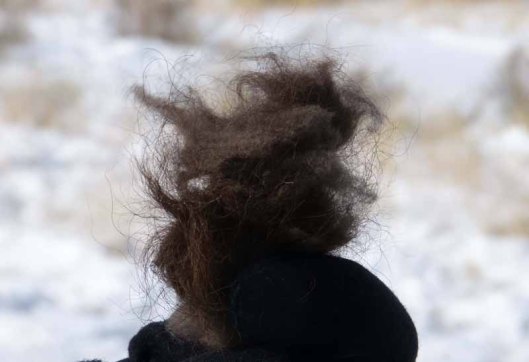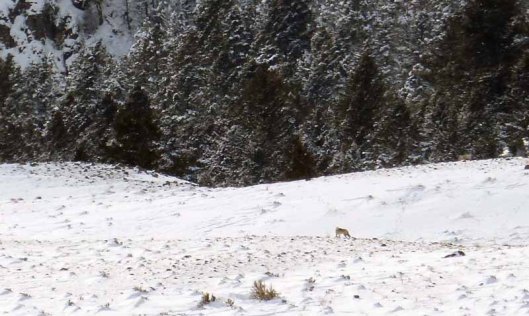Tags
American dipper, American magpie, American raven, Bald eagle, Bison, bison fur, Bozeman, coyote, Gardiner, geological dyke, Greater Yellowstone ecosystem, ice jam, Liberty Cap Mammoth, Mammoth Hot Springs, moose, Pronghorn, Roosevelt Arch, Tinker's Hill, Tinker's Hill Cemetery, travertine terrace, Wapiti Lake wolf pack, wolf, wolf reintroduction, Yellowstone, Yellowstone National Park, |National Museum of Wildlife Art
USA 2018 (14), Wolves! Yes, on this last day of our Yellowstone ‘safari’, we did see wolves. It was slightly less cold (about minus 23ºC/minus 9ºF) as we left Cooke City on Wednesday 22nd February, making an even earlier start, at 6.30 a.m.
The last wolf pack in Yellowstone Park was killed in the 1920s. On 12th January 1995 the first wolves for decades were released here, and, by the end of 1996, 31 of them had been relocated from Canada to the park. They and their descendants have changed the ecosystem, with an enormously beneficial effect on fauna and flora, there now being a top predator where there was none for decades, rebalancing nature. Here is a 4’34” video on how. (Another, on a wild wolf playing with domestic dogs, shows just how huge the wolf is.) [Three weeks later. There’s a snippet in March’s ‘BBC Wildlife Magazine about this phenomenon. ‘Predators don’t just eat prey animals, they scare the hell out of them, and this fear factor alone is enough to shape ecosystems. After wolves disappeared from Yellowstone National Park, elk were free to forage wherever their tastebuds led them, including into lush but risky riverbank habitats. This led to the devastation of specialist riparian vegetation. When wolves were reintroduced, the elk looked elsewhere and the riverbanks recovered.’]
Once more heading for Mammoth Hot Springs, our first stop was to watch a moose eating its favourite food, willow – recovered thanks to the wolves perhaps. I got interested in an American dipper (nothing like European ones) by a river
I got interested in an American dipper (nothing like European ones) by a river and I walked back a few yards to take a closer look.
and I walked back a few yards to take a closer look. Imagine my astonishment on turning round after a few minutes, at seeing this!
Imagine my astonishment on turning round after a few minutes, at seeing this! Of course any coyote likes an easy surface to walk on, and this one walked right on by me, and through my companions by the vehicles.
Of course any coyote likes an easy surface to walk on, and this one walked right on by me, and through my companions by the vehicles. We next stopped to observe a young bison’s carcase being recycled, about half a mile from where we were on the road.
We next stopped to observe a young bison’s carcase being recycled, about half a mile from where we were on the road.

All very symmetrical: American ravens to the left, a coyote on either side of the carcase, and American magpies to the right
By midday we had reached and gone through Mammoth, turning north to Tinker’s Hill, Gardiner, and the North Entrance to the NP. This is the Roosevelt Arch, (1903).

On the other, entrance, side of the Arch, there is engraved, ‘For the benefit and enjoyment of the people’.

 We were now technically out of the Park, but still well within the wider ecosystem of Yellowstone. I wandered around a little, while telescopes were being set up.
We were now technically out of the Park, but still well within the wider ecosystem of Yellowstone. I wandered around a little, while telescopes were being set up.

There are worse locations for a cemetery.

Tim encouraged me to feel this bison fur he had found an a fence. It was so soft!

Whimsical landscape on Sprinter window
And I joined the others, patiently seeking a wolf pack known to hang out around here.
YES! Not with the naked eye, but with binoculars, cameras and ‘scopes. The Wapiti Lake pack I believe, itself inside the Park boundary. About two miles away. (Just very occasionally – very occasionally – I wish I carried around one of those paparazzi cameras with enormously long lenses, instead of the small thing I wear slung around my neck.)




Here – really – they have moved to the further ridge and are lying down

There is even a black wolf or two there…
In due course they disappeared over the ridge.
”Turn around! Pronghorn!” We had seen a very graceful sculpture of a pronghorn at the National Museum of Wildlife Art at Jackson Hole. Here were a whole crowd of them in the flesh. Such delicate creatures, not at all fazed by our presence. (They are sometimes called pronghorn antelope, but they are deer. Most photos slightly over-exposed.)



 It was back to Mammoth for lunch, and a look at the Lower Travertine Terraces.
It was back to Mammoth for lunch, and a look at the Lower Travertine Terraces. 


The extinct cone is known as the Liberty Cap, after the cap worn by colonial patriots in the Revolutionary War
Then we had a serious drive back north to Bozeman, where we were to catch our planes home the next day. We stopped briefly at the Roosevelt Arch, but saw no wolves this time, but (apologies to those of a squeamish nature) I thought this bison poo there was really artistic. It was too fast a drive for any real photography, though I did manage to get these bald eagles.
It was too fast a drive for any real photography, though I did manage to get these bald eagles. We also saw white-tailed deer, and some bison, and I noticed a fabulous geological dyke. Looking around at a comfort stop by the Yellowstone River, Drew told us that this was evidence that there had been an ice jam somewhere nearby.
We also saw white-tailed deer, and some bison, and I noticed a fabulous geological dyke. Looking around at a comfort stop by the Yellowstone River, Drew told us that this was evidence that there had been an ice jam somewhere nearby.
 Approaching Bozeman I took a final picture of the mountains.
Approaching Bozeman I took a final picture of the mountains.

I think the form at the top of the mountain is a cirque.
It was minus 10ºC/plus 14ºF when we arrived at Bozeman. The leaders commented that this had been the coldest trip they had ever known.
Most of my companions were going straight home. I was to embark on the third and final part of my journey the following day – after a lie-in!

Well I still can’t tell the difference between a coyote and a wolf – but glad you weren’t disappointed. Loved the pronghorns – such pretty creatures!
LikeLike
Immense size difference for a start, but as you know, we didn’t get near enough to use that as a criterion!
LikeLike
What an amazing trip.
LikeLike
Indeed it was.
LikeLike
Thank you for sharing this. It was exciting just reading it so it must have great fun to be there.
LikeLike
I’m always suspicious of those wildlife stories where the sought after animal shows up just as everyone is starting to pack up to go home, but here I lived one!
LikeLiked by 1 person
Thanks for all the photographs, they made a fascinating record of your day.
LikeLike
Yes – varied as ever in Yellowstone. A return one Spring gets added to the list of travel wishes. Fulfilment is quite another matter!
LikeLike
Great vidios and descriptions. Very glad you saw the wolves at last. What a magnificent trip.
LikeLike
It was indeed – and it was not over yet. Two more posts to come.
LikeLike
Wolves!! So exciting!! They’re such phenomenally incredible creatures!
LikeLiked by 1 person
Yes. After such a wonderful trip I could have had nothing to complain about if we hadn’t had the ‘good’ view on this last day, but it did round off the ‘safari’ brilliantly.
LikeLiked by 1 person
I honestly don’t think I’d be able to contain my excitement if I saw wolves in the wild, even if the view wasn’t very good.
LikeLiked by 1 person
Lagging behind as usual has the advantage that I could curtail your suspense and meet the wolves! It’s really as if they came to say farewell to you and your group.
I like very much your Sprinter window and the overexposed tones of the pronghorns.
Roosevelt Arch : they could now add “…and of bison!”
LikeLike
When I first saw the overexposed pictures, I wondered about correcting them in Photoshop, but a) I don’t know how, and b) I like the tones – especially of the sweet couple.
LikeLike
Me too 😉
LikeLiked by 1 person